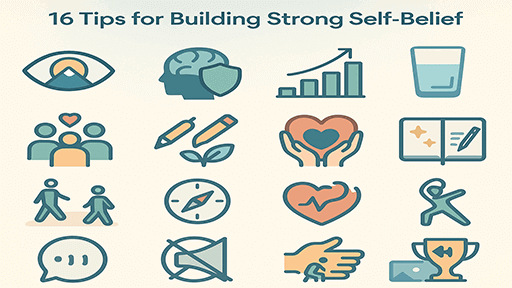16 Tips for Building Strong Self-Belief:
Self-belief—the confidence in your own abilities and judgment—is one of the most critical psychological strengths you can cultivate. It influences your decisions, shapes your resilience in the face of setbacks, and defines how you approach both challenges and opportunities in life. People with strong self-belief are more likely to pursue goals with persistence, overcome adversity, and maintain a positive self-image even during difficult times (Bandura, 1997). Fortunately, self-belief is not a fixed trait; it’s something that can be developed and strengthened with intentional effort. In the rest of this article, we will explore 16 tips for building strong self-belief.
1. Visualize Success: Visualization involves mentally rehearsing a situation or outcome you want to achieve. This isn’t about wishful thinking—it’s about training your brain to recognize and respond to success-oriented scenarios. Neuroscience research shows that when we vividly imagine ourselves performing a task successfully, the same neural networks are activated as when we actually perform the task (Decety & Ingvar, 1990).
Example: Imagine you’re preparing for a job interview. Before the interview day, you close your eyes and picture yourself walking confidently into the room, greeting the panel with a firm handshake, answering questions clearly, and seeing the interviewers nod in approval. You even imagine receiving the call that says, “You got the job!” This mental rehearsal prepares your mind and body to perform as if you’ve already succeeded.
Why it works: Athletes use visualization to improve performance, and many top performers credit it as a key part of their success toolkit. For example, Olympic swimmer Michael Phelps is known to mentally rehearse every race in detail before jumping into the pool.
✅ “Visualization is daydreaming with a purpose.” – Bo Bennett
2. Challenge Negative Self-Talk: We all have an inner voice that comments on our actions. When this voice turns critical—saying things like “You’re not good enough” or “You always mess up”—it can erode your self-belief. Cognitive Behavioral Therapy (CBT) teaches that thoughts influence feelings and behavior, so learning to challenge unhelpful thoughts is essential for mental health and confidence (Beck, 2011).
Example: You’re about to give a class presentation and you catch yourself thinking, “Everyone is going to think I’m stupid.” Using a CBT-based approach, you stop and ask: What’s the evidence for this? Have I done presentations before? Did people really laugh or criticize me? Replacing the thought with something more realistic like, “I’ve prepared well, and I know the topic,” helps reduce anxiety and boosts self-belief.
Why it works: Changing internal dialogue can shift how you perceive yourself. Over time, more constructive thoughts become automatic, making you more resilient and confident in challenging situations.
✅ “Don’t believe everything you think.” – Unknown
3. Set and Achieve Small Goals: One of the most effective ways to strengthen self-belief is through small wins. Each time you set a goal and achieve it, you prove to yourself that you’re capable. According to Locke and Latham’s goal-setting theory (2002), specific and challenging (yet achievable) goals enhance performance and self-efficacy.
Example: Let’s say you want to improve your public speaking, but the thought of giving a 10-minute talk terrifies you. Instead of jumping straight into a big speech, start by asking a question during a meeting. Next time, volunteer to give a 2-minute summary. Gradually, these steps build your skill and confidence, making the bigger goal feel realistic.
Why it works: Small, repeated successes create a feedback loop: effort → success → confidence → more effort. This reinforces the belief that you can improve and succeed.
✅ “Success is the sum of small efforts, repeated day in and day out.” – Robert Collier
4. Celebrate Progress, Not Perfection: Perfectionism is often the enemy of self-belief. When you constantly measure yourself against an ideal, you’re likely to feel inadequate. Celebrating progress—however small—nurtures a growth mindset, helping you focus on improvement rather than unrealistic standards (Dweck, 2006).
Example: You’re learning graphic design. Your first project isn’t perfect—colors clash, and the layout is clumsy. But instead of saying, “I’m terrible at this,” you recognize, “I learned how to use two new tools in this software, and my spacing is better than last time.” This way, you’re acknowledging your progress, which motivates you to keep going.
Why it works: A growth mindset helps you see effort as valuable and failure as informative. This makes you more persistent and less afraid of trying new things—critical traits for self-belief.
✅ “Progress, not perfection, is what we should be asking of ourselves.” – Julia Cameron
5. Surround Yourself with Encouragers: The people you spend time with can either build you up or tear you down. According to Bandura’s social learning theory (1986), we learn behaviors and form beliefs by observing others. When you’re around individuals who believe in you and reflect back your strengths, it becomes easier to believe in yourself too.
Example: Imagine you’ve joined a creative writing class. You’re nervous about sharing your work, but your classmates are supportive. One classmate says, “You have a really unique voice,” while another adds, “I could feel the emotion in your piece.” This positive reinforcement helps silence your doubts and motivates you to keep writing.
Why it works: Encouragement acts like a mirror—showing you a version of yourself you might not see. Encouragers help you recognize your value and potential, especially when your self-perception is clouded by fear or doubt.
✅ “You are the average of the five people you spend the most time with.” – Jim Rohn
6. Embrace Failure as Feedback: Failure isn’t the opposite of success—it’s part of the path to it. People with strong self-belief see setbacks as opportunities to learn and grow. Carol Dweck (2006) identified this as a “growth mindset”—the belief that abilities can be developed through dedication and effort.
Example: Thomas Edison reportedly failed thousands of times before inventing the light bulb. When asked about these failures, he famously said, “I have not failed. I’ve just found 10,000 ways that won’t work.” This attitude turned failure into valuable data, not defeat.
Why it works: When you treat failure as feedback, it loses its power to discourage you. You become more resilient and adaptable—qualities that reinforce your belief in your ability to overcome obstacles.
✅ “Only those who dare to fail greatly can ever achieve greatly.” – Robert F. Kennedy
7. Practice Self-Compassion: Self-compassion means being kind to yourself when you’re struggling or feel inadequate. Dr. Kristin Neff (2011), a leading researcher on self-compassion, found that people who treat themselves with care rather than criticism are more motivated, emotionally balanced, and self-assured.
Example: You missed an important deadline at work. Instead of beating yourself up with thoughts like “I’m so stupid” or “I can’t do anything right,” you say, “I’m disappointed, but I’ve been under a lot of pressure lately. Everyone makes mistakes.” Then you reflect on how to avoid the same issue next time.
Why it works: Self-compassion doesn’t mean letting yourself off the hook. It means giving yourself the same empathy and encouragement you’d give a friend—building emotional resilience and self-worth in the process.
✅ “Talk to yourself like you would to someone you love.” – Brené Brown
8. Keep a “Success Journal”: It’s easy to forget your accomplishments, especially when you’re focused on what’s going wrong. Keeping a success journal—a written record of your daily or weekly wins—helps you stay connected to your strengths and progress. Writing about positive events can even improve mental health and self-esteem (Pennebaker & Seagal, 1999).
Example: At the end of each day, write down 1–3 things you did well. It could be something as small as “I spoke up in the meeting” or “I went for a walk instead of procrastinating.” Over time, these entries become tangible proof that you are capable and progressing.
Why it works: In moments of self-doubt, reading back through your journal reminds you of your growth. This builds your self-concept and gives you concrete evidence of your ability to overcome challenges and succeed.
✅ “Success is nothing more than a few simple disciplines, practiced every day.” – Jim Rohn
9. Learn New Skills: When you acquire a new skill—whether it’s technical, creative, or interpersonal—you reinforce your belief in your capacity to grow and adapt. According to Bandura (1997), one of the strongest sources of self-efficacy (self-belief in your ability to succeed) comes from “mastery experiences”—achievements you accomplish through effort.
Example: Let’s say you’re terrified of speaking in public. You join a local Toastmasters club and start practicing once a month. At first, your voice shakes. But with each speech, you gain confidence. Six months later, you’re speaking comfortably in front of groups. That transformation—earned through persistence—becomes a powerful reminder that you can learn and grow.
Why it works: Every new skill adds to your internal portfolio of competence. Even small wins like learning to cook a new recipe or use a new software program can make you feel more capable and self-reliant.
✅ “Once we believe in ourselves, we can risk curiosity, wonder, spontaneous delight…” – E.E. Cummings
10. Avoid Comparison Traps: Comparing yourself to others can quickly sabotage your self-belief. According to Festinger’s (1954) social comparison theory, we naturally evaluate our abilities by comparing ourselves to others—but doing this constantly, especially in today’s social media age, can lead to feelings of inadequacy and insecurity.
Example: You’re proud of finishing your first 5K run. But then you scroll through Instagram and see someone else completing a marathon. Suddenly, your achievement feels “small.” This kind of thinking is misleading—it ignores context, experience, and your personal growth journey.
Why it works: Focusing on your own progress rather than others’ highlight reels helps protect your self-worth. Measuring yourself against your past self—not someone else—keeps the emphasis on growth rather than unrealistic expectations.
✅ “Comparison is the thief of joy.” – Theodore Roosevelt
11. Affirm Your Values: When you consciously align your actions with your core values—like honesty, compassion, creativity, or service—you strengthen your sense of identity and self-respect. Research by Cohen and Sherman (2014) shows that value-affirmation exercises can reduce stress, bolster self-worth, and increase resilience in the face of criticism or challenge.
Example: If one of your values is perseverance, and you’ve recently been struggling with a difficult exam or project, reminding yourself of this value can help reframe the challenge. “This is hard, but sticking with it reflects who I am.” That internal affirmation acts as an anchor, reminding you of your strength.
Why it works: When you live in alignment with what matters most to you, you experience integrity—a deep sense of self-trust. This reinforces the belief that you’re capable of living a meaningful, intentional life, even when things get tough.
✅ “When your values are clear to you, making decisions becomes easier.” – Roy E. Disney
12. Take Care of Your Body: Physical well-being significantly impacts mental well-being. Regular exercise, good sleep, and proper nutrition aren’t just about physical health—they directly influence mood, energy, and confidence. Dr. John Ratey (2008) in Spark explains how exercise boosts brain function, reduces anxiety, and improves learning—all of which support a stronger self-image.
Example: You begin a morning routine that includes 20 minutes of brisk walking. After two weeks, you notice more energy, clearer thinking, and less anxiety. As your physical stamina improves, you also feel more capable mentally—and this confidence spills over into your work and relationships.
Why it works: Caring for your body sends a powerful message to yourself: I matter. When you feel physically strong and energized, it becomes easier to believe in your ability to handle life’s challenges.
✅ “The mind and body are not separate. What affects one, affects the other.” – Unknown
13. Speak with Confidence: The way you speak can influence how others see you—and how you see yourself. Speaking clearly, assertively, and with conviction can actually change your internal self-perception, a concept supported by self-perception theory (Bem, 1972), which suggests that we form beliefs about ourselves by observing our own behavior.
Example: You’re in a group discussion and have an idea to share. Instead of mumbling, “I think maybe we could…” you say, “Here’s an idea I believe could work well.” Even if you were nervous, speaking with clarity and authority boosts how you feel about yourself—and how seriously others take you.
Why it works: The act of behaving confidently—even if you don’t feel confident yet—can rewire your brain. Over time, this creates a feedback loop where confident speech reinforces confident thinking.
✅ “Fake it till you become it.” – Amy Cuddy
14. Limit Toxic Input: Negative or toxic environments—whether online or in real life—can drain your energy and erode self-belief. This includes overly critical people, negative news cycles, or social media content that constantly triggers comparison. Exposure to persistent negativity is linked to decreased mental well-being and lower self-esteem (Twenge & Campbell, 2009).
Example: You notice that after scrolling through social media, you often feel unmotivated or inferior. You decide to unfollow accounts that make you feel “less than” and instead subscribe to creators who offer encouragement, education, or inspiration. Within a week, your mood and motivation noticeably improve.
Why it works: Reducing exposure to negativity helps preserve mental space for growth, creativity, and belief in your potential. You’re less likely to internalize limiting beliefs when you’re not surrounded by limiting messages.
✅ “You can’t hang out with negative people and expect to live a positive life.” – Joel Osteen
15. Mentor or Help Others: Helping others learn or grow reinforces your own knowledge and reminds you of your value. The Helper Therapy Principle (Riessman, 1965) states that people who support others often benefit as much, or more, than the person receiving the help—because teaching or guiding others boosts your own confidence and purpose.
Example: You volunteer to help a younger student who’s struggling with math. As you explain concepts and see their progress, you realize how much you’ve learned and how capable you are. Their growth becomes proof of your own ability to lead, guide, and support.
Why it works: By mentoring others, you not only affirm your competence—you also shift your focus away from self-doubt toward contribution. Helping someone else succeed often awakens your own sense of empowerment.
✅ “We rise by lifting others.” – Robert Ingersoll
16. Reflect on Past Successes: When facing a tough challenge, remembering times when you’ve overcome difficulties or succeeded before can powerfully boost self-belief. This draws on the psychological concept of self-continuity—the idea that your past achievements are part of a continuous thread of growth and capability (Pillemer & Kuwabara, 2012).
Example: You’re feeling nervous about a major presentation. To prepare, you pull out a folder of past feedback you received from teachers or supervisors—positive emails, project scores, or notes that said, “Well done.” Reviewing these memories reminds you that you’ve succeeded before—and can do so again.
Why it works: Reconnecting with your previous wins helps override your current self-doubt. It reframes the situation from “I don’t know if I can do this” to “I’ve done difficult things before, and I got through them.”
✅ “Sometimes you have to look back to see how far you’ve come.” – Unknown
In conclusion, building strong self-belief isn’t about blind confidence or ignoring your weaknesses. It’s about recognizing your worth, embracing your capacity to grow, and nurturing a mindset that helps you persevere despite challenges. As Albert Bandura (1997) aptly emphasized, “People’s beliefs about their abilities have a profound effect on those abilities.” By incorporating the above strategies into your life, you’re not just learning how to believe in yourself—you’re practicing it, day by day. And like any other skill, the more you practice, the stronger it becomes.
Frequently Asked Questions (FAQs):
Is self-belief the same as self-confidence?
They’re closely related, but they’re not exactly the same. Self-belief is the deeper foundation—it’s your inner trust that you are capable, worthy, and able to grow through life’s challenges. Self-confidence is more about how that belief shows up in specific situations. For example, you might believe in your ability to learn, but not feel confident giving a speech—yet. Think of self-belief as the root, and self-confidence as the visible branches. The stronger the root, the more the branches grow.
I’ve failed so many times. Can I still build self-belief?
Absolutely—and in fact, those failures might become your greatest teachers. Everyone fails at something. What matters most is how you respond. If you see failure as a sign that you’re not good enough, it can crush your belief. But if you start to view failure as a normal, even necessary part of learning, you’ll begin to build resilience. Every time you get back up after falling, you’re proving to yourself that you’re strong, determined, and capable of growth. Self-belief grows when you keep going, not when things are perfect.
How long does it take to build strong self-belief?
There’s no one-size-fits-all answer. It depends on your experiences, mindset, and how consistently you work on it. Some people start noticing changes within a few weeks of practicing positive habits like journaling, goal-setting, or speaking up for themselves. For others—especially those dealing with years of self-doubt—it might take longer. That’s okay. What’s important is progress, not speed. Self-belief isn’t built in a single moment—it’s built in the choices you make every day.
Can therapy help me with low self-belief?
Yes, it can help a lot. Talking to a therapist gives you a safe space to explore where your self-doubt comes from and how to change it. Sometimes we carry beliefs from childhood, past relationships, or past mistakes that we didn’t even realize were affecting us. A good therapist can help you untangle that, replace harmful thoughts with more empowering ones, and guide you through the process of rediscovering your worth.
What if the people around me don’t support or believe in me?
That’s one of the hardest things to deal with, but it doesn’t have to stop you. While encouragement from others feels good, it’s not a requirement for building your own self-belief. In fact, some of the strongest, most resilient people build their belief in spite of the people who doubted them. Start by becoming your own supporter—speak kindly to yourself, track your wins, and stay focused on your goals. If possible, seek out people who do encourage you, even if it’s just one person. And remember: you don’t need everyone to believe in you—you are enough.
Is it possible to have too much self-belief?
Yes, but what people often mistake for “too much self-belief” is usually overconfidence or arrogance. Healthy self-belief is balanced—it includes self-awareness, humility, and a willingness to learn from mistakes. True self-belief doesn’t make you feel superior to others; it helps you stay grounded and steady, even when things get hard. When it’s real, self-belief shows up as quiet strength, not loud bragging.
I’m confident in one part of my life but feel insecure in others. Is that normal?
Completely normal. Self-belief doesn’t always spread evenly across every area of your life. You might feel confident at work but feel unsure socially. Or you might be a strong caregiver but feel insecure about your creative skills. That’s okay. The good news is that the belief you’ve built in one area can be transferred to others. Use your strengths as a reminder: If I can do this, maybe I can learn to do that too.
What daily habits can help me build and maintain self-belief?
Great question! Here are some small, powerful habits you can try every day:
- Morning affirmations: Start your day by reminding yourself of your worth. Say things like, “I am capable,” “I am learning,” or “I can handle what comes.”
- Gratitude journaling: Write down a few things you’re proud of or grateful for. This keeps your mind focused on the positive.
- Set small goals: Complete one meaningful task each day, even if it’s small. It helps prove to yourself that you can follow through.
- Move your body: Exercise—even light movement—helps you feel more energized and confident.
- Reflect at night: Ask yourself, “What did I do well today?” Ending the day on a positive note helps you sleep better and wake up stronger.
These habits aren’t magic, but when practiced consistently, they gently reshape how you see yourself.
References:
- Bandura, A. (1986). Social Foundations of Thought and Action: A Social Cognitive Theory. Prentice-Hall.
- Bandura, A. (1997). Self-efficacy: The exercise of control. W.H. Freeman.
- Beck, J. S. (2011). Cognitive Behavior Therapy: Basics and Beyond. Guilford Press.
- Bem, D. J. (1972). Self-perception theory. In L. Berkowitz (Ed.), Advances in experimental social psychology (Vol. 6). Academic Press.
- Cohen, G. L., & Sherman, D. K. (2014). The psychology of change: Self-affirmation and social psychological intervention. Annual Review of Psychology, 65, 333–371. https://doi.org/10.1146/annurev-psych-010213-115137
- Decety, J., & Ingvar, D. H. (1990). Brain structures participating in mental simulation of motor behavior: A neuropsychological interpretation. Acta Psychologica, 73(1), 13–34. https://doi.org/10.1016/0001-6918(90)90056-L
- Dweck, C. S. (2006). Mindset: The New Psychology of Success. Random House.
- Festinger, L. (1954). A theory of social comparison processes. Human Relations, 7, 117–140. https://doi.org/10.1177/001872675400700202
- Locke, E. A., & Latham, G. P. (2002). Building a practically useful theory of goal setting and task motivation: A 35-year odyssey. American Psychologist, 57(9), 705–717. https://doi.org/10.1037/0003-066X.57.9.705
- Neff, K. (2011). Self-compassion: The proven power of being kind to yourself. William Morrow.
- Pennebaker, J. W., & Seagal, J. D. (1999). Forming a story: The health benefits of narrative. Journal of Clinical Psychology, 55(10), 1243–1254. https://doi.org/10.1002/(SICI)1097-4679(199910)55:10<1243::AID-JCLP6>3.0.CO;2-N
- Pillemer, D. B., & Kuwabara, K. J. (2012). Directive functions of autobiographical memory: Theory and method. In D. Berntsen & D. C. Rubin (Eds.), Understanding autobiographical memory: Theories and approaches (pp. 181–201). Cambridge University Press. https://doi.org/10.1017/CBO9781139021937.014
- Ratey, J. J. (2008). Spark: The Revolutionary New Science of Exercise and the Brain. Little, Brown Spark.
- Riessman, F. (1965). The “helper” therapy principle. Social Work, 10(2), 27–32. https://www.jstor.org/stable/23708219
- Twenge, J. M., & Campbell, W. K. (2009). The Narcissism Epidemic: Living in the Age of Entitlement. Free Press.

Library Lecturer at Nurul Amin Degree College










